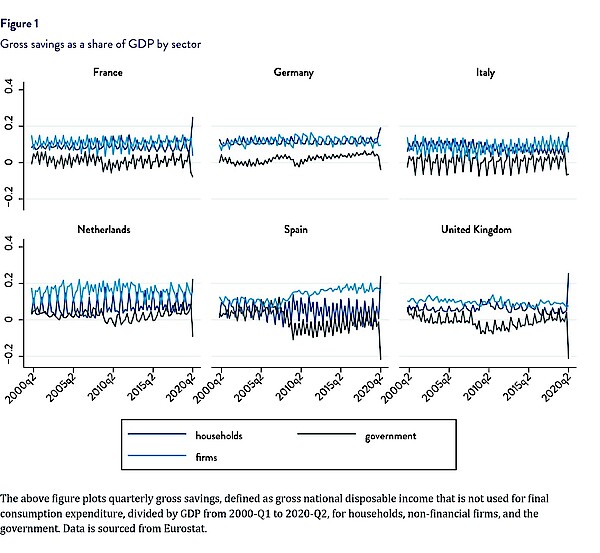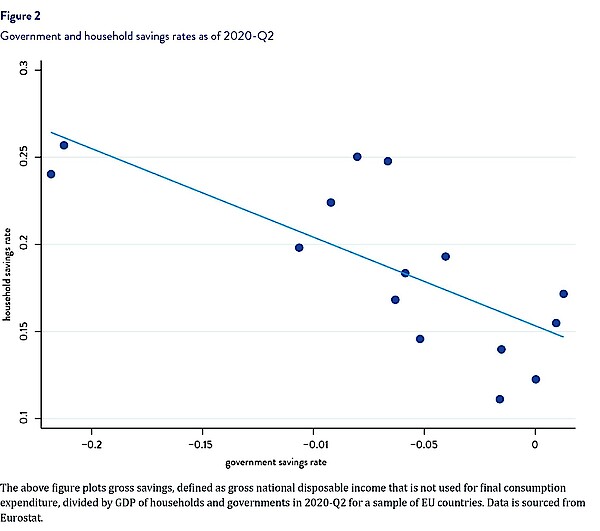
Why Are Households Saving so much During the Corona Recession?
Savings rates among European households have reached record levels during the Corona recession. We investigate three possible explanations for the increase in household savings: precautionary motivations induced by increased economic uncertainty, reduced consumption opportunities due to lockdown measures, and Ricardian Equivalence, i.e. increases in the expected future tax-burden of households driven by increases in government debt. To test these explanations, we compile a monthly panel of euro area countries from January 2019 to August 2020. Our findings indicate that the chief driver of the increase in household savings is supply: As governments restrict households’ opportunities to spend, households spend less. We estimate that going from no lockdown measures to that of Italy’s in March, would have resulted in the growth of Germany’s deposit to Gross Domestic Product (GDP) ratio being 0.6 percentage points higher each month. This would be equivalent to the volume of deposits increasing by roughly 14.3 billion euros or 348 euros per house monthly. Demand effects, driven by either fears of unemployment or fear of infection from COVID-19, appear to only have a weak impact on household savings, whereas changes in government debt are unrelated or even negatively related to savings rates. The analysis suggests that there is some pent-up demand for consumption that may unravel after lockdown measures are abolished and may result in a significant increase in consumption in the late spring/early summer 2021.
01. Februar 2021
Inhalt
Seite 1
IntroductionSeite 2
Data and Summary StatisticsSeite 3
ResultsSeite 4
Endnoten Auf einer Seite lesenIntroduction
Savings rates among European households have reached record levels during the Corona recession (see Figure 1). Simultaneously, the average debt to GDP ratio of the euro area is expected to increase by 15% through 2020,1 although the degree to which this is driven by increased spending, as opposed to decreased tax receipts, varies substantially by country. The sharp rise in household savings rates appears high enough to completely offset the increase in government deficit spending at the aggregate, while firm savings rates remain largely unchanged, such that countries’ economy wide savings rates (private and public) are roughly unchanged relative to their pre-COVID-19 levels.
Understanding why households are saving so much is crucial for understanding how and when we should expect aggregate demand to return to pre-COVID-19 levels. In this note, we propose three explanations for the sharp rise in savings and assess their ability to explain variation in household savings across European countries.
Perhaps the most obvious explanation for the increase in savings is reduced consumption opportunities related to lockdown measures. By shutting down restaurants, discouraging travel, and limiting retail capacity, governments reduced consumers’ opportunities to spend. While consumers may substitute these lost consumption opportunities with online spending, many may prefer to bide their time until they can travel or eat out again. This explanation can be thought as the supply hypothesis as, under this explanation, the decline in household consumption is not driven by demand. If households were unable to spend, a relaxation of measures may then result in a strong, perhaps short-lived consumption boom in the spring/summer of 2021. Especially those sectors that particularly suffered during the lockdown (tourism, restaurants, retail stores) would benefit.
Another intuitive explanation is that the increase in savings is driven by a decline in household demand. Fears of future employment income losses associated with increased economic uncertainty may have driven households to accumulate precautionary savings. It is well established in the theoretical and empirical literature that economic uncertainty associated with recessions drives households to reduce consumption.2 This explanation would tie a recovery in consumption to the economic recovery: To the extent that economic uncertainty persists even after lockdown measures have been phased out and adjustments to economic preferences due to Corona imply substantial structural adjustments, we would expect the recovery in consumption to be weak in 2021.
The third explanation is related to the sharp increase in deficit spending associated with the fiscal response packages to the recession. As households are forward looking, debt-financed increases in government spending may induce households to save in anticipation of future tax hikes to pay off the government’s debt. In the academic literature, this is known as Ricardian Equivalence.3 If households are worried about future tax payments, the increase in savings will persist until governments substantially reduce their deficits and debt levels. Hence, the recovery in consumption in 2021 can be expected to be weak based on this explanation as well.
In the cross-sectional data, we observe a relationship that appears to be consistent with Ricardian Equivalence (see Figures 1 and 2). In other words, countries where the government is running a higher deficit also happen to be countries where households are saving more.


An alternative interpretation of Figure 2 is, however, that causality runs in the other direction: As households reduced spending due to lockdown measures and uncertainty, governments increased spending to offset this shortfall. Moreover, the reduction in household spending reduces tax revenue, mechanically resulting in a negative relationship. However, this could only explain at most one third of the relationship, as according to the OECD’s Global Revenue Statistics Database, on average, 33.7% of eurozone governments’ revenue is sourced from consumption based taxes. The extent to which each of these hypotheses can explain the increase in savings has profound implications for government policy and the economic recovery. If households only increased savings due to reduced consumption opportunities, pent up consumer demand could come roaring back as soon as governments decide it is safe to ease lockdown measures. Accordingly, too much government spending under such circumstances could lead to inflation if it continues after lockdown measures are removed. On the other hand, the extent to which rising savings are driven by precautionary motivations, the greater importance of assuring households that their employment is secure through countercyclical spending. Here, too little government spending could result in a vicious cycle of weak demand. However, if Ricardian Equivalence is the most prominent driver of increased household savings, then increasing fiscal rescue packages may only worsen aggregate demand shortfalls by increasing households’ expected future tax burdens.
We find no evidence that households reduced consumption to save for future taxes. If anything, the relationship is the reverse, as the coefficient on government debt on household savings is negative, although insignificant. Moreover, fear of unemployment and the severity of the virus appear to only explain a small share of the variation in savings rates. The most important driver of increased savings appears to be government lockdowns.
Our analysis suggests that the recovery in aggregate consumption will be rapid once mobility restrictions are suspended. It is possible and perhaps even likely that post-COVID-19 demand will temporarily exceed pre-COVID-19 levels as consumers return to normalcy with record levels of deposits. In contrast to the financial crisis, which severely dented households’ housing wealth in many countries, this time households will, on average, exit the crisis with more wealth than they had going into the crisis.
The relatively weak or non-existent importance of unemployment expectations in explaining variations in deposits stands in contrast to the results of Mody, Ohnsorge, and Sandri (2012) for the Great Recession, who find that labour income uncertainty drives two-fifths of the increase in savings in advanced economies. Consistent with our results, Dossche and Zlatanos (2020)4 find that while unemployment expectations drive a sizable share of the variation in savings in the past, it is unable to explain the recent rise in savings during the Corona recession.





